Structural, Thermal, and Release Properties of Hybrid Materials Based on Layered Zinc Hydroxide and Caffeic Acid
Abstract
1. Introduction
2. Materials and Methods
Materials and Synthesis of Samples
2.1.1. Synthesis of Layered Zinc Hydroxide
2.1.2. Synthesis of Hybrid Material
2.1.3. Characterization of Hybrid Materials
2.1.4. Controlled Release Studies
3. Results and Discussion
3.1. Elemental Analysis
3.2. Interfacial Characterization
3.3. Powder X-Ray Diffraction (PXRD)
3.4. Thermal Analysis (TG/DTA)
3.5. FT-IR Spectroscopy
3.6. Scanning Electron Microscopy (SEM)
3.7. X-Ray Photoelectron Spectroscopy (XPS)
3.8. Controlled Release
3.9. Kinetic Analysis
4. Conclusions
Author Contributions
Funding
Acknowledgments
Conflicts of Interest
References
- Oh, J.-M.; Biswick, T.T.; Choy, J.-H. Layered nanomaterials for green materials. J. Mater. Chem. 2009, 19, 2553. [Google Scholar] [CrossRef]
- Rojas, R.; Linck, Y.G.; Cuffini, S.L.; Monti, G.A.; Giacomelli, C.E. Structural and physicochemical aspects of drug release from layered double hydroxides and layered hydroxide salts. Appl. Clay Sci. 2015, 109, 119–126. [Google Scholar] [CrossRef]
- Kalali, E.N.; Wang, X. Multifunctional intercalation in layered double hydroxide: Toward multifunctional nanohybrids for epoxy resin. J. Mater. Chem. A 2016, 4, 2147–2157. [Google Scholar] [CrossRef]
- Arízaga, G.G.C.; da Costa Gardolinski, J.E.F.; Schreiner, W.H.; Wypych, F. Intercalation of an oxalatooxoniobate complex into layered double hydroxide and layered zinc hydroxide nitrate. J. Colloid Interface Sci. 2009, 330, 352–358. [Google Scholar] [CrossRef] [PubMed]
- Carlino, S.; Hudson, M.J. Thermal intercalation of layered double hydroxides: Capric acid into an Mg-AI LDH. J. Mater. Chem. 1995, 5, 1433. [Google Scholar] [CrossRef]
- Gasser, M. Inorganic layered double hydroxides as ascorbic acid (vitamin C) delivery system—Intercalation and their controlled release properties. Colloids Surf. B Biointerfaces 2009, 73, 103–109. [Google Scholar] [CrossRef] [PubMed]
- Saifullah, B.; Hussein, M.Z.B.; Bullo, S.; Hussein, M.Z. Inorganic nanolayers: Structure, preparation, and biomedical applications. Int. J. Nanomed. 2015, 10, 5609–5633. [Google Scholar]
- Barahuie, F.; Hussein, M.Z.; Fakurazi, S.; Zainal, Z. Development of drug delivery systems based on layered hydroxides for nanomedicine. Int. J. Mol. Sci. 2014, 15, 7750–7786. [Google Scholar] [CrossRef]
- Bull, R.M.R.; Markland, C.; Williams, G.R.; O’Hare, D. Hydroxy double salts as versatile storage and delivery matrices. J. Mater. Chem. 2011, 21, 1822–1828. [Google Scholar] [CrossRef]
- Moezzi, A.; Cortie, M.B.; Shimmon, R.; McDonagh, A.M. On the Reactivity of Zinc Hydroxide Acetate Dihydrate in Ethanol. Eur. J. Inorg. Chem. 2013, 2013, 5133–5137. [Google Scholar] [CrossRef]
- Arizaga, G.G.C.; Satyanarayana, K.; Wypych, F. Layered hydroxide salts: Synthesis, properties and potential applications. Solid State Ion. 2007, 178, 1143–1162. [Google Scholar] [CrossRef]
- Latip, A.F.A.; Hussein, M.Z.; Stanslas, J.; Wong, C.C.; Adnan, R.; Latip, A.A.; Latip, A.F.A. Release behavior and toxicity profiles towards A549 cell lines of ciprofloxacin from its layered zinc hydroxide intercalation compound. Chem. Cent. J. 2013, 7, 119. [Google Scholar] [CrossRef]
- Hussein, S.H.; al Ali, H.; Al-Qubaisi, M.; el Zowalaty, M.; Hussein, M.Z.; Ismail, M. Antimicrobial activity of hippurate nanocomposite and its cytotoxicity effect in combination with cytarabine against HL-6. J. Nanomater. 2013, 2013, 843647. [Google Scholar] [CrossRef]
- Silion, M.; Hritcu, D.; Lisa, G.; Popa, M.I. New hybrid materials based on layered double hydroxides and antioxidant compounds. Preparation, characterization and release kinetic studies. J. Porous Mater. 2012, 19, 267. [Google Scholar] [CrossRef]
- Baykal, A.; Amir, M.; Günerb, S.; Sözeri, H. Preparation and characterization of SPION functionalized via caffeic acid. J. Magn. Magn. Mater. 2015, 395, 199–204. [Google Scholar] [CrossRef]
- Swisłocka, R. Spectroscopic (FT-IR, FT-Raman, UV absorption, 1H and 13C NMR) and theoretical (in B3LYP/6-311++G** level) studies on alkali metal salts of caffeic acid. Spectrochim. Acta Part A Mol. Biomol. Spectrosc. 2013, 100, 21–30. [Google Scholar] [CrossRef]
- Gao, T.; Ci, Y.; Jian, H.; An, C. FTIR investigation of the interaction of tumor cells treated with caffeic acid and chlorogenic acid. Vib. Spectrosc. 2000, 24, 225. [Google Scholar] [CrossRef]
- Wei, Y.; Gao, Y.; Zhang, K.; Ito, Y. Isolation of Caffeic Acid from Eupatorium Adenophorum Spreng by High-Speed Countercurrent Chromatography and Synthesis of Caffeic Acid-Intercalated Layered Double Hydroxide. J. Liq. Chromatogr. Relat. Technol. 2010, 33, 837–845. [Google Scholar] [CrossRef]
- Biswick, T.; Park, D.-H.; Choy, J.-H. Enhancing the UV A1 screening ability of caffeic acid by encapsulation in layered basic zinc hydroxide matrix. J. Phys. Chem. Solids 2012, 73, 1510–1513. [Google Scholar] [CrossRef]
- Moezzi, A.; McDonagh, A.; Dowd, M. Cortie, Zinc hydroxyacetate and its transformation to nanocrystalline zinc oxide. Inorg. Chem. 2013, 52, 95. [Google Scholar] [CrossRef]
- Ruiz, C.V.; Rodriguez-Castellón, E.; Giraldo, O. Structural analysis and conduction mechanism in polycrystalline zinc hydroxide nitrate. Inorg. Chem. 2018, 57, 9067. [Google Scholar] [CrossRef]
- Moulder, J.F.; Sobol, W.F.; Bomben, K.D. Handbook of X-ray Photoelectron Spectroscopy; Physical Electronic Division, Perkin-Elmer Corporation: Eden Praire, MN, USA, 1995. [Google Scholar]
- Multipak Software; Version 9.6.0.15.; Physical Electronics: Chanhassen, MN, USA, 2015.
- Interactive Crystal & Molecular Modelling; Version 9.2.6.; CrystalMaker Software: Begbroke, UK, 2015.
- Xu, Z.P.; Jin, Y.; Liu, S.; Hao, Z.P.; Lu, G.Q. Surface charging of layered double hydroxides during dynamic interactions of anions at the interfaces. J. Colloid Interface Sci. 2008, 326, 522–529. [Google Scholar] [CrossRef]
- Xu, Z.P.; Stevenson, G.; Lu, C.Q.; Lu, G.Q. Dispersion and size control of layered double hydroxide nanoparticles in aqueous solutions. J. Phys. Chem. B 2006, 110, 16923–16929. [Google Scholar] [CrossRef]
- Tran, H.N.; Lin, C.C.; Woo, S.H.; Chao, H.P. Efficient removal of copper and lead by Mg/Al layered double hydroxides intercalated with organic acid anions: Adsorption kinetics, isotherms, and thermodynamics. Appl. Clay Sci. 2018, 154, 17–27. [Google Scholar] [CrossRef]
- Zhao, J. Synthesis of functionalized MgAl-layered double hydroxides via modified mussel inspired chemistry and their application in organic dye adsorption. J. Colloid Interface Sci. 2017, 505, 168–177. [Google Scholar] [CrossRef]
- Moaty, S.A. Synthesis and characterization of LDH-type anionic nanomaterials for effective removal of doxycycline from aqueous media. Water Environ. J. 2019, 1–34. [Google Scholar] [CrossRef]
- Joseph, E.; Singhvi, G. Multifunctional nanocrystals for cancer therapy: A potential nanocarrier. Nanomater. Drug Deliv. Ther. 2019, 91–116. [Google Scholar] [CrossRef]
- Poul, L.; Jouini, N.; Fiévet, F. Layered Hydroxide Metal Acetates (Metal=Zinc, Cobalt, and Nickel): Elaboration via Hydrolysis in Polyol Medium and Comparative Study. Chem. Mater. 2000, 12, 3123–3132. [Google Scholar] [CrossRef]
- Xiao, Z.; Guo, M.; Guo, R. Thermal decomposition mechanism and kinetics of ursolic acid and caffeic acid. Chem. Ind. For. Prod. 2014, 34, 33–39. [Google Scholar]
- Biwick, T.; Jones, W.; Pacuła, A.; Serwicka, E.; Podobinski, J. The role of anhydrous zinc nitrate in the thermal decomposition of the zinc hydroxy nitrates Zn5(OH)8(NO3)2·2H2O and ZnOHNO3·H2O. J. Solid State Chem. 2007, 180, 1171–1179. [Google Scholar] [CrossRef]
- Tavares, S.R.; Vaiss, V.S.; Wypych, F.; Leitão, A.A. Theoretical study of the anion exchange properties and the thermal decomposition of Zn5(OH)8(NO3)2·2H2O and Zn5(OH)8(NO3)2·2NH3. Appl. Clay Sci. 2015, 114, 103. [Google Scholar] [CrossRef]
- Thomas, N.; Rajamathi, M. Near 100% selectivity in anion exchange reactions of layered zinc hydroxy nitrate. J. Colloid Interface Sci. 2011, 362, 493–496. [Google Scholar] [CrossRef]
- Stählin, W.; Oswald, H.R. The infrared spectrum and thermal analysis of zinc hydroxide nitrate. J. Solid State Chem. 1971, 3, 252–255. [Google Scholar] [CrossRef]
- Nakamoto, K. Complex of sulfate, carbonate and related ligands. In Infrared and Raman Spectra of Inorganic and Coordination Compounds, 5th ed.; John Wiley & Sons, Inc.: New York, NY, USA, 2008; pp. 80–88. [Google Scholar]
- Nara, M.; Torii, H.; Tasumi, M. Correlation between the vibrational frequencies of the carboxylate group and the types of its coordination to a metal ion: An ab initio molecular orbital study. J. Phys. Chem. 1996, 100, 19812. [Google Scholar] [CrossRef]
- Song, R.Q.; Xu, A.W.; Deng, B.; Li, Q.; Chen, G.Y. From layered basic zinc acetate nanobelts to hierarchical zinc oxide nanostructures and porous zinc oxide nanobelts. Adv. Funct. Mater. 2007, 17, 296. [Google Scholar] [CrossRef]
- Kumar, N.; Pruthi, V.; Goel, N. Estructural, thermal and quantum chemical studies of p-coumaric and caffeic acids. J. Mol. Struct. 2015, 1085, 242. [Google Scholar] [CrossRef]
- Selma, S.D.; Chong, R.; Patel, R.; Williams, G.R. Intercalation and controlled release of bioactive ions using a hydroxy double salt. Ind. Eng. Chem. Res. 2012, 51, 2913. [Google Scholar]
- Liu, J.; Zhang, X.; Zhang, Y. Preparation and Release Behavior of Chlorpyrifos Adsolubilized into Layered Zinc Hydroxide Nitrate Intercalated with Dodecylbenzenesulfonate. ACS Appl. Mater. Interfaces 2015, 7, 11180–11188. [Google Scholar] [CrossRef]
- Addinsoft. XLSTAT Statistical and Data Analysis Solution; Addinsoft: Paris, France, 2019; Available online: https://www.xlstat.com (accessed on 10 December 2019).

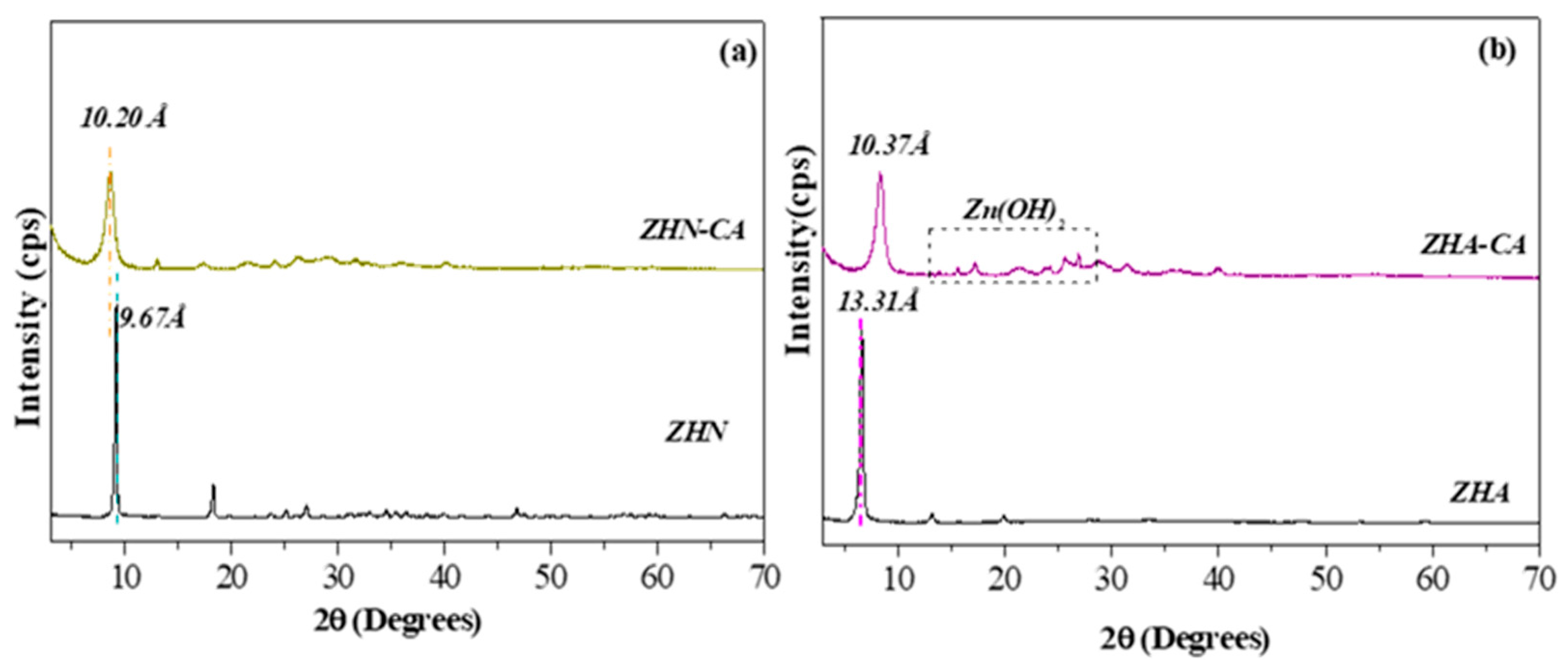


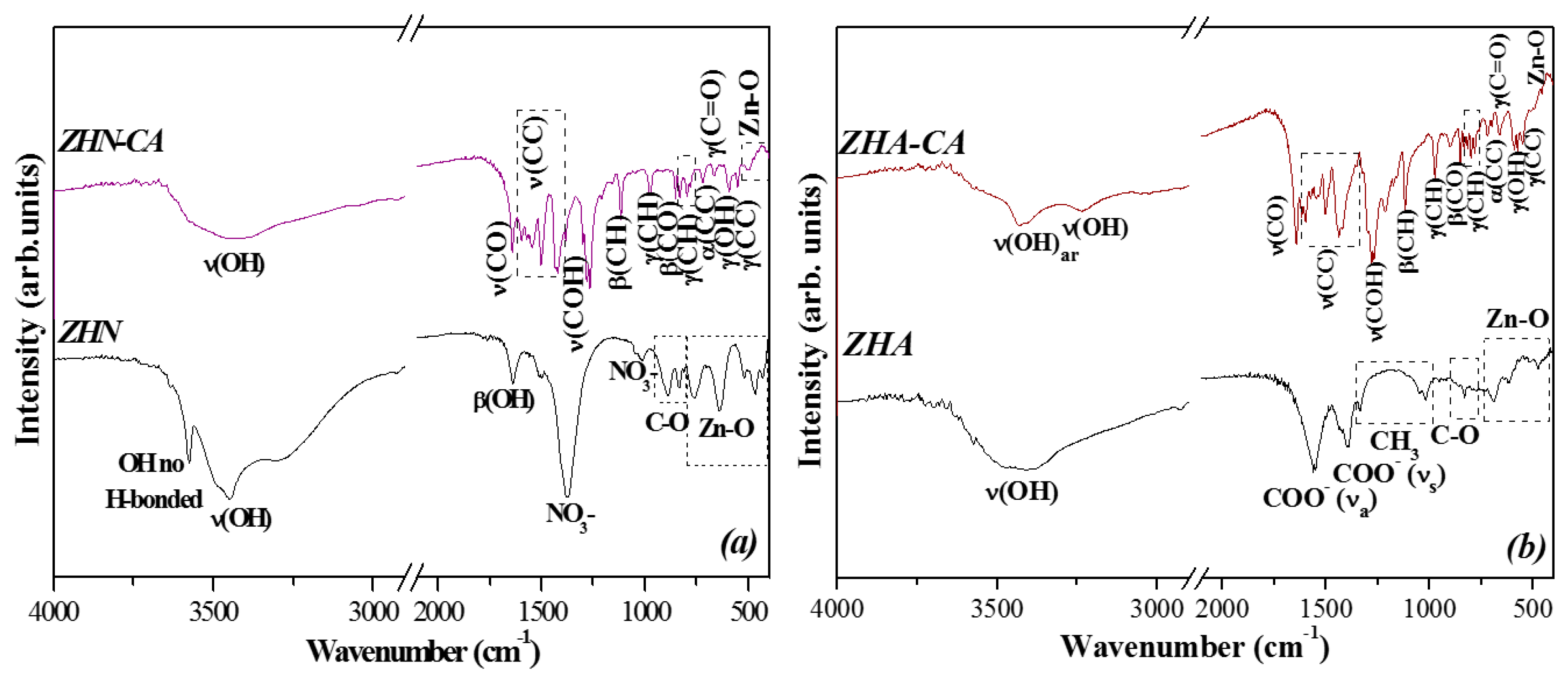
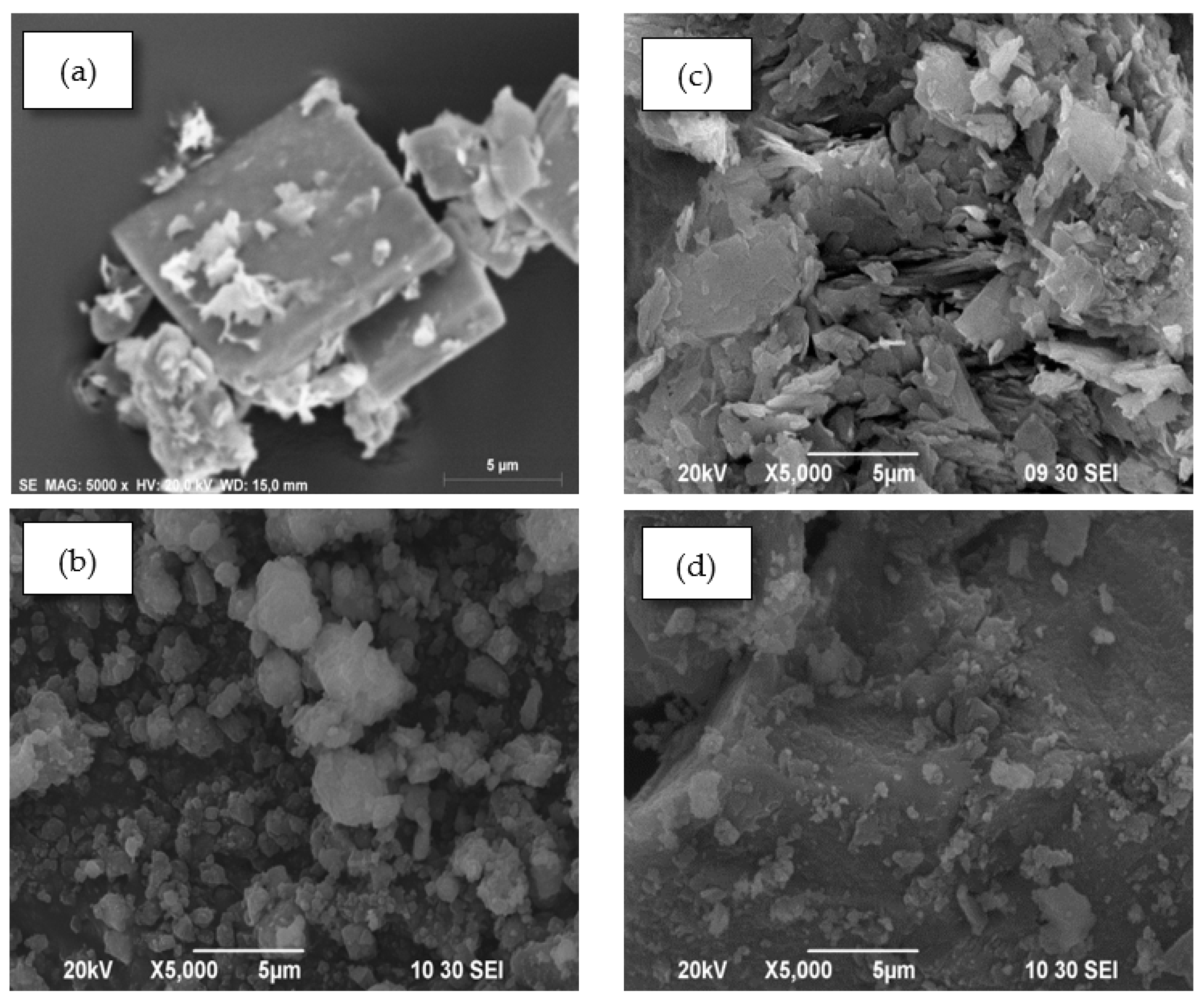
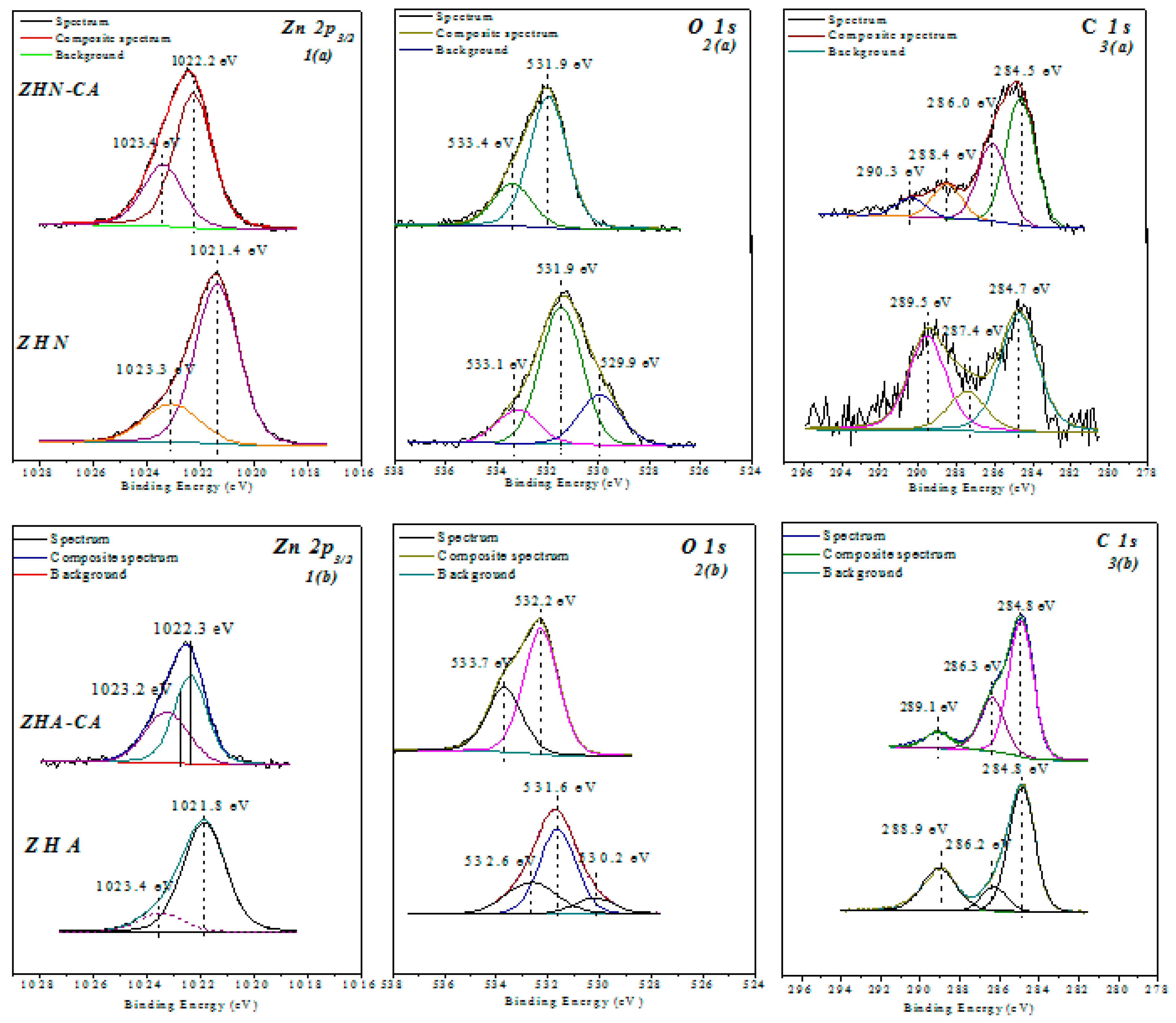

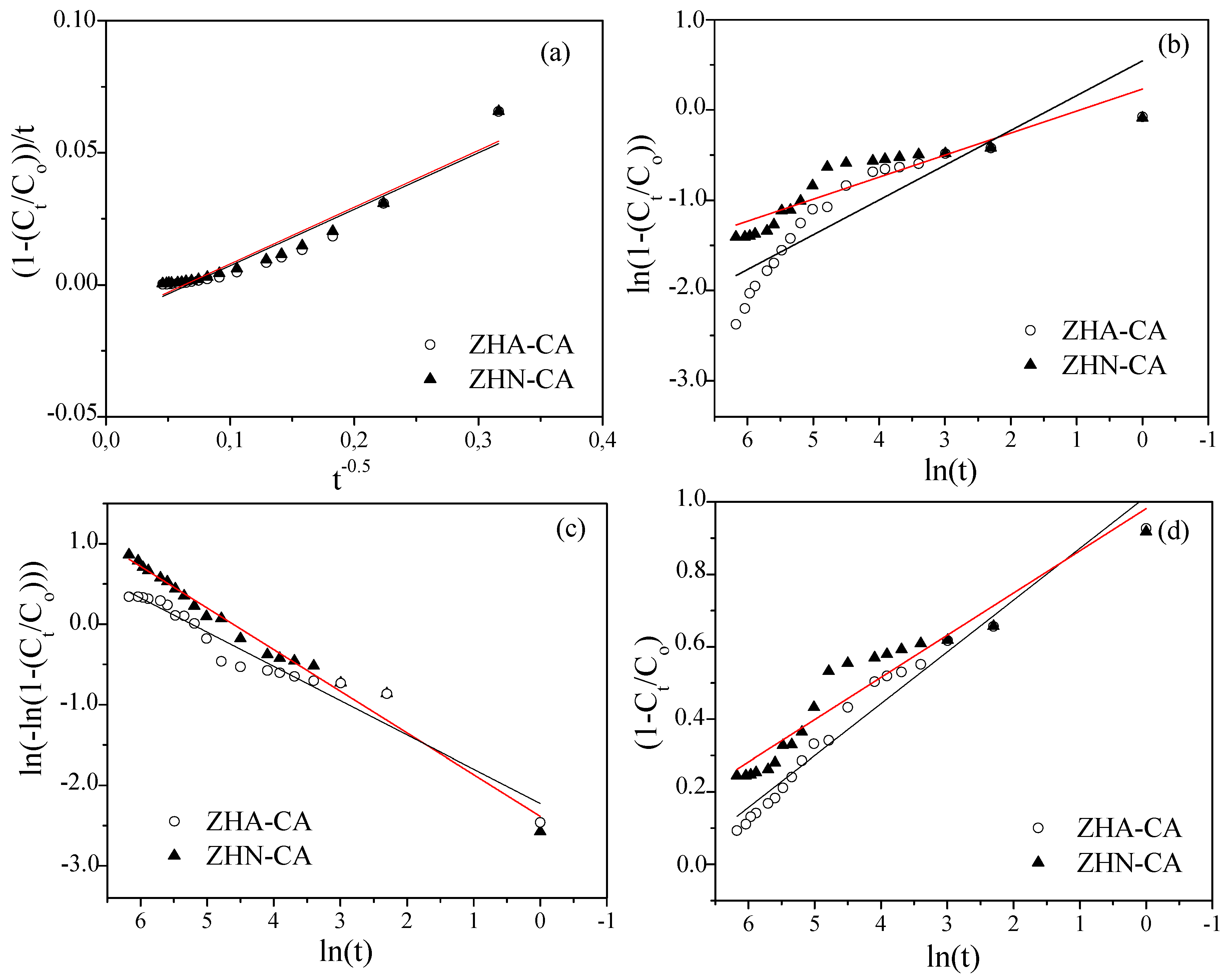
| Hybrid Material | Calculated Formula | Elemental Content Percentages Observed (Calculated) (wt.%) | |||
|---|---|---|---|---|---|
| Zn | C | N | H | ||
| ZHN | Zn5(OH)8(NO3)1.6(CO3)0.2·1.7H2O * | 54.5 (54.1) | 0.4 (0.4) | 3.6 (3.7) | 1.9 (1.9) |
| ZHA | Zn5(OH)7.5(C2H3O2)2.5∙3H2O | 50.0 (49.8) | 9.3 (9.1) | - | 3.2 (3.2) |
| ZHN–CA | Zn5(OH)8(C9H7O4)2 | 38.7 (39.8) | 27.5 (26.3) | - | 2.4 (2.7) |
| ZHA–CA | Zn5(OH)7.5(C9H7O4)2.5∙H2O | 38.1 (35.5) | 29.3 (25.2) | - | 3.0 (2.9) |
| Model | Equation | R2 | |
|---|---|---|---|
| ZHN–CA | ZHA–CA | ||
| Parabolic | (1 − Ct/C0)/t = kd(t − t0)−0.5 + a | 0.9293 | 0.9139 |
| Freundlich | ln(1 − Ct/C0) = ln(kd) + aln((t − t0)) | 0.8378 | 0.7837 |
| Elovich | 1 − Ct/C0 = aln((t − t0)) + b | 0.9554 | 0.9206 |
| Avrami-Erofe’ev | ln(−ln(Ct/C0)) = nlnkd + nln(t − t0) | 0.9754 | 0.9494 |
© 2020 by the authors. Licensee MDPI, Basel, Switzerland. This article is an open access article distributed under the terms and conditions of the Creative Commons Attribution (CC BY) license (http://creativecommons.org/licenses/by/4.0/).
Share and Cite
Ruiz, C.V.; Becerra, M.E.; Giraldo, O. Structural, Thermal, and Release Properties of Hybrid Materials Based on Layered Zinc Hydroxide and Caffeic Acid. Nanomaterials 2020, 10, 163. https://doi.org/10.3390/nano10010163
Ruiz CV, Becerra ME, Giraldo O. Structural, Thermal, and Release Properties of Hybrid Materials Based on Layered Zinc Hydroxide and Caffeic Acid. Nanomaterials. 2020; 10(1):163. https://doi.org/10.3390/nano10010163
Chicago/Turabian StyleRuiz, Christhy V., María E. Becerra, and Oscar Giraldo. 2020. "Structural, Thermal, and Release Properties of Hybrid Materials Based on Layered Zinc Hydroxide and Caffeic Acid" Nanomaterials 10, no. 1: 163. https://doi.org/10.3390/nano10010163
APA StyleRuiz, C. V., Becerra, M. E., & Giraldo, O. (2020). Structural, Thermal, and Release Properties of Hybrid Materials Based on Layered Zinc Hydroxide and Caffeic Acid. Nanomaterials, 10(1), 163. https://doi.org/10.3390/nano10010163





